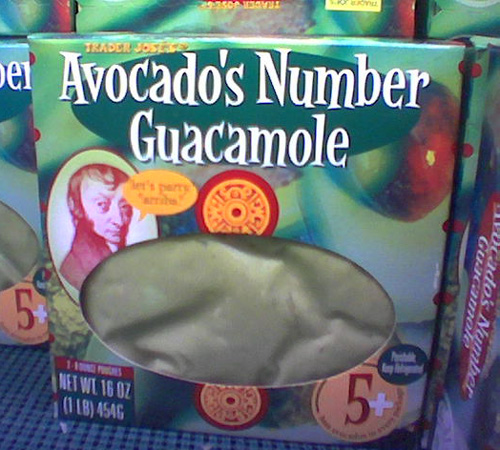This is National Chemistry Week. It’s always chosen to coincide with whichever calendar week includes October 23 (or 10/23), since October 23 is “Mole Day”.
“Huh? Why would chemists celebrate a furry critter that burrows underground?”
Not that mole. The mole chemists celebrate is a unit.
1 mole = 6.02 x 1023 of whatever it is you want a mole of.
You can think of a mole as being sort of the chemists’ equivalent of a dozen — it’s a convenient sized bundle for working with the kind of stuff chemists work with, namely, atoms and molecules. If they were working with eggs, or shoes, or some other stuff, they would probably use a different unit than the mole.
Remember that atoms are really, really small. They are so small that you’ve never seen one with your naked eye. (Depending on how you score things like diamonds, you may have seen a molecule with your naked eye, but even most molecules are way beyond the limits of your visual acuity.) If passing intro chem depended on doing experiments where you had to weigh out single atoms of reagents, there would be no chemists.
Weighing out 6.02 x 1023 atoms, though, is do-able. 6.02 x 1023 atoms of carbon weigh 12.01 grams. 6.02 x 1023 atoms of copper weigh 63.55 grams. 6.02 x 1023 atoms of helium weigh 4.003 grams.
I don’t have any of this memorized. I just turned to my handy, dandy periodic table. Under each element’s symbol is listed an atomic weight. Carbon’s atomic weight is 12.01. That means a single atom of carbon has a mass of 12.01 atomic mass units (amu). However, since we’ve already noted that you hardly ever want to deal with one atom at a time (at least if you’re a chemist — maybe physicists would rather deal with single atoms), the more important fact that you can glean from the table is that 6.02 x 1023 atoms of carbon have a mass of 12.01 grams. Or, simply, 1 mole of carbon is 12.01 g.
Once you recognize that atomic masses tell you how many grams in a mole of an element, you can measure your desired amount of multi-element molecules, too. Table salt is NaCl. Na has atomic mass of 23, Cl has atomic mass of 35.5, so a mole of NaCl (or 6.02 x 1023 molecules of NaCl) is 58.5 g. To find the mass of a mole of H2O, you have 2 moles of H (atomic weight 1) and one of O (atomic weight 16) — 18 g of H2O holding all 6.02 x 1023 molecules.
From this, it’s a good bet that mixing an equal number of moles of table salt and water will not yield a saline solution so much as a slightly damp pile of salt.
In addition to being the number of atoms or molecules (or shoes, or eggs, or pencils, etc.) in a mole, 6.02 x 1023 has a name that sticks in people’s heads: Avogadro’s number. Avogadro also has a law:
Equal volumes of gases at the same temperature and pressure contain the same number of molecules.
If we’re dealing with “ideal gases (gases whose molecules are not too enormous, and which don’t have significant attractions between the molecules), at standard temperature and pressure (0 o C and 1 atm), 22.4 liters of gas will contain 6.02 x 1023 molecules (or 1 mole). So, at standard temperature of pressure, balloons filled with 22.4 L of H2, N2, O2, Cl2, He, Ne, and Ar will each contain a mole of gas molecules. However, the masses of gasses in these balloons will be different (2 g, 28 g, 32 g, 71 g, 4 g, 20 g, and 40 g, respectively). This means a mole of argon is denser — by a lot — than a mole of helium.
That Avogadro’s number of [anything] equals a mole of [that stuff] has also given rise to clever marketing, like this:

The label clarifies that there are not actually 6.02 x 1023 avocados in each package of guacamole (it’s closer to 5 or 6). But it’s a fine store bought guacamole, and the chemistry joke on the package just makes it more appealing.
Happy Mole Day!

I’ve thought of Avogadro’s Number as Avocado’s Number since the dim, long-ago days of high school chemistry. Curiously, although I’ve forgotten very much, 6.02 x 10^23 has always stuck with me.
Avogadro’s Number has remained lodged in my memory, too. So much information I’d be more likely to actually use has left, but this remains.
So much information I’d be more likely to actually use has left, but this remains.
In connection with which, I want this tee shirt: http://www.cafepress.com/dd/19657951
Just a minor nit-pick. One atom of carbon doesn’t weigh 12.01 amu. One atom of carbon weighs either 12, 13, or 14 amu, depending on which isotope you are dealing with. The weighted average of all carbon isotopes is 12.01 amu (because carbon-12 is far more abundant than the heavier isotopes, the average is much closer to 12 amu).
Great post and well stated, otherwise. I will use it to help reinforce the concepts of the mole with my lower chemistry students.
This reminds me of an essay by Isaac Asimov : “How to tell a chemist”. Quoting from memory :
Just ask the question – What is a mole? A normal person will say “A small, furry animal”, a civil engineer will say “A breakwater”, but a chemist will say “Well, its like this…” and keep going for 30 minutes.
Nice article. At the previous school I worked at, one of the chemistry teachers had a project where the kids could earn extra credit by making a mole (as in, the cute critter) for Mole Day.
Extra extra credit for carving a 12.01-gram mole from pure graphite?